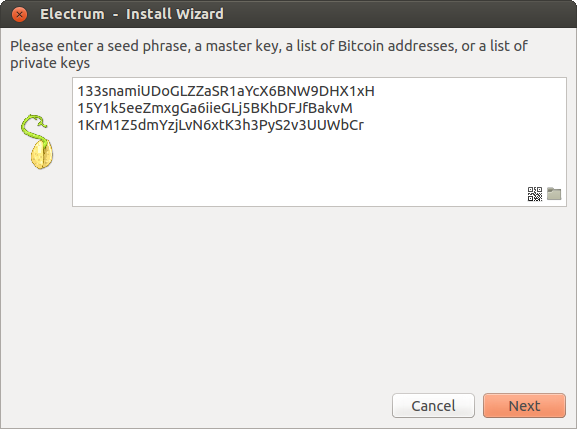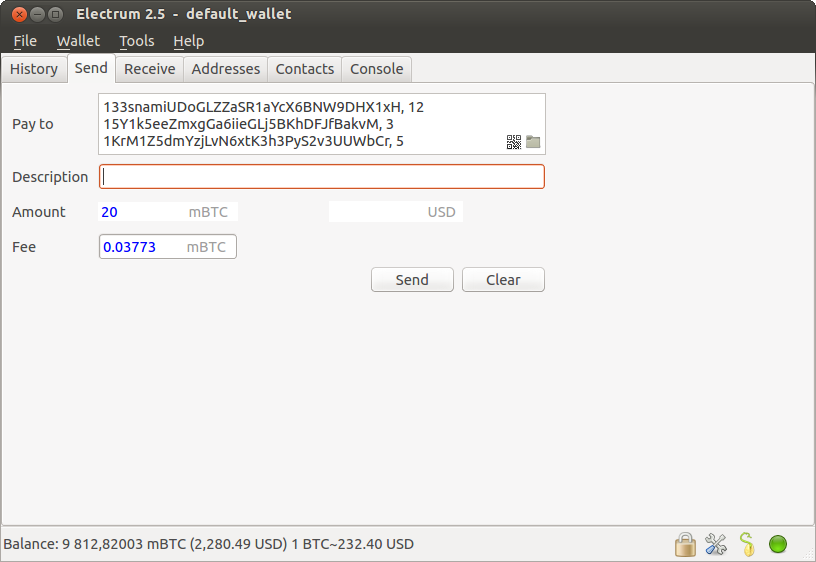Frequently Asked Questions¶
How does Electrum work?¶
Electrum's focus is speed, with low resource usage and simplifying Bitcoin. Startup times are instant because it operates in conjunction with high-performance servers that handle the most complicated parts of the Bitcoin system.
Does Electrum trust servers?¶
Not really; the Electrum client never sends private keys to the servers. In addition, it verifies the information reported by servers, using a technique called Simple Payment Verification
What is the seed?¶
The seed is a random phrase that is used to generate your private keys.
Example:
slim sugar lizard predict state cute awkward asset inform blood civil sugar
Your wallet can be entirely recovered from its seed. For this, select the "restore wallet" option in the startup.
How secure is the seed?¶
The seed phrase created by Electrum has 132 bits of entropy. This means that it provides the same level of security as a Bitcoin private key (of length 256 bits). Indeed, an elliptic curve key of length n provides n/2 bits of security.
I have forgotten my password. What can I do?¶
It is not possible to recover your password. However, you can restore your wallet from its seed phrase and choose a new password. If you lose both your password and your seed, there is no way to recover your money. This is why we ask you to save your seed phrase on paper.
To restore your wallet from its seed phrase, create a new wallet, select the type, choose "I already have a seed" and proceed to input your seed phrase.
My transaction has been unconfirmed for a long time. What can I do?¶
Bitcoin transactions become "confirmed" when miners accept to write them in the Bitcoin blockchain. In general, the speed of confirmation depends on the fee you attach to your transaction; miners prioritize transactions that pay the highest fees.
Recent versions of Electrum use "dynamic fees" in order to make sure that the fee you pay with your transaction is adequate. This feature is enabled by default in recent versions of Electrum.
If you have made a transaction that is unconfirmed, you can:
- Wait for a long time. Eventually, your transaction will either be confirmed or cancelled. This might take several days.
- Increase the transaction fee. This is only possible for "replaceable" transactions. To create this type of transaction, you must have checked "Replaceable" on the send tab before sending the transaction. If you're not seeing the "Replaceable" option on the send tab go to Tools menu > Preferences > Fees tab and set "Propose Replace-By-Fee" to "Always". Transactions that are replaceable have the word "Replaceable" in the date column on the history tab. To increase the fee of a replaceable transaction right click on its entry on the history tab and choose "Increase Fee". Set an appropriate fee and click on "OK". A window will popup with the unsigned transaction. Click on "Sign" and then "Broadcast".
- Create a "Child Pays for Parent" transaction. A CPFP is a new transaction that pays a high fee in order to compensate for the small fee of its parent transaction. It can be done by the recipient of the funds, or by the sender, if the transaction has a change output. To create a CPFP transaction right click on the unconfirmed transaction on the history tab and choose "Child pays for parent". Set an appropriate fee and click on "OK". A window will popup with the unsigned transaction. Click on "Sign" and then "Broadcast".
What does it mean to "freeze" an address in Electrum?¶
When you freeze an address, the funds in that address will not be used for sending bitcoins. You cannot send bitcoins if you don't have enough funds in the non-frozen addresses.
How is the wallet encrypted?¶
Electrum uses two separate levels of encryption:
- Your seed and private keys are encrypted using AES-256-CBC. The private keys are decrypted only briefly, when you need to sign a transaction; for this you need to enter your password. This is done in order to minimize the amount of time during which sensitive information is unencrypted in your computer's memory.
- In addition, your wallet file may be encrypted on disk. Note that the wallet information will remain unencrypted in the memory of your computer for the duration of your session. If a wallet is encrypted, then its password will be required in order to open it. Note that the password will not be kept in memory; Electrum does not need it in order to save the wallet on disk, because it uses asymmetric encryption (ECIES).
Wallet file encryption is activated by default since version 2.8. It is intended to protect your privacy, but also to prevent you from requesting bitcoins on a wallet that you do not control.
Does Electrum support cold wallets?¶
Yes, see Cold Storage.
Can I import private keys from other Bitcoin clients?¶
In Electrum 2.0, you cannot import private keys in a wallet that has a seed. You should sweep them instead.
If you want to import private keys and not sweep them, you need to create a special wallet that does not have a seed. For this, create a new wallet, select "restore", and instead of typing your seed, type a list of private keys, or a list of addresses if you want to create a watching-only wallet.

You will need to back up this wallet, because it cannot be recovered from a seed.
Can I sweep private keys from other Bitcoin clients?¶
Sweeping private keys means to send all the bitcoins they control to an existing address in your wallet. The private keys you sweep do not become a part of your wallet. Instead, all the bitcoins they control are sent to an address that has been deterministically generated from your wallet seed.
To sweep private keys, go to the Wallet menu -> Private Keys -> Sweep. Enter the private keys in the appropriate field. Leave the "Address" field unchanged. That is the destination address and it will be from your existing electrum wallet. Click on "Sweep". It'll now take you to the send tab where you can set an appropriate fee and then click on "Send" to send the coins to your wallet.
Where is my wallet file located?¶
The default wallet file is called default_wallet, which is created when you first run the application and is located in the /wallets folder.
On Windows:
- Show hidden files
- Go to \Users\YourUserName\AppData\Roaming\Electrum\wallets (or %APPDATA%\Electrum\wallets)
On Mac:
- Open Finder
- Go to folder (shift+cmd+G) and type ~/.electrum
On Linux:
- Home Folder
- Go -> Location and type ~/.electrum
Can I do bulk payments with Electrum?¶
You can create a transaction with several outputs. In the GUI, type each address and amount on a line, separated by a comma.

Amounts are in the current unit set in the client. The total is shown in the GUI.
You can also import a CSV file in the "Pay to" field, by clicking on the folder icon.
Can Electrum create and sign raw transactions?¶
Electrum lets you create and sign raw transactions right from the user interface using a form.
Electrum freezes when I try to send bitcoins.¶
This might happen if you are trying to spend a large number of transaction outputs (for example, if you have collected hundreds of donations from a Bitcoin faucet). When you send Bitcoins, Electrum looks for unspent coins that are in your wallet in order to create a new transaction. Unspent coins can have different values, much like physical coins and bills.
If this happens, you should consolidate your transaction inputs by sending smaller amounts of bitcoins to one of your wallet addresses; this would be the equivalent of exchanging a stack of nickels for a dollar bill.
What is the gap limit?¶
The gap limit is the maximum number of consecutive unused addresses in your deterministic sequence of addresses. Electrum uses it in order to stop looking for addresses. In Electrum 2.0, it is set to 20 by default, so the client will get all addresses until 20 unused addresses are found.
How can I pre-generate new addresses?¶
Electrum will generate new addresses as you use them, until it hits the gap limit.
If you need to pre-generate more addresses, you can do so by typing wallet.create_new_address(False) in the console. This command will generate one new address. Note that the address will be shown with a red background in the address tab to indicate that it is beyond the gap limit. The red color will remain until the gap is filled.
WARNING: Addresses beyond the gap limit will not automatically be recovered from the seed. To recover them will require either increasing the client's gap limit or generating new addresses until the used addresses are found.
If you wish to generate more than one address, you can use a "for" loop. For example, if you wanted to generate 50 addresses, you could do this:
for x in range(0, 50):
print wallet.create_new_address(False)
How do I upgrade Electrum?¶
Warning: always save your wallet seed on paper before doing an upgrade.
To upgrade Electrum, just install the most recent version. The way to do this will depend on your OS.
Note that your wallet files are stored separately from the software, so you can safely remove the old version of the software if your OS does not do it for you.
Some Electrum upgrades will modify the format of your wallet files.
For this reason, it is not recommended to downgrade Electrum to an older version once you have opened your wallet file with the new version. The older version will not always be able to read the new wallet file.
The following issues should be considered when upgrading Electrum 1.x wallets to Electrum 2.x:
- Electrum 2.x will need to regenerate all of your addresses during the upgrade process. Please allow it time to complete, and expect it to take a little longer than usual for Electrum to be ready.
- The contents of your wallet file will be replaced with an Electrum 2 wallet. This means Electrum 1.x will no longer be able to use your wallet once the upgrade is complete.
- The "Addresses" tab will not show any addresses the first time you launch Electrum 2. This is expected behavior. Restart Electrum 2 after the upgrade is complete and your addresses will be available.
- Offline copies of Electrum will not show the addresses at all because it cannot synchronize with the network. You can force an offline generation of a few addresses by typing the following into the Console: wallet.synchronize(). When it's complete, restart Electrum and your addresses will once again be available.